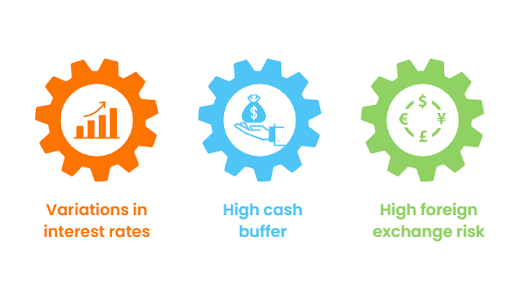How cash management system can help manage global recession in 2022
Learn how to protect your cash flows from a recession and how a cash management system can help the global recession in 2022.
Overview of global recession 2022- What’s expected?
From 1854 to the most recent recession in 2020, the United States has experienced 34 recessions, according to the NBER. The International Monetary Fund (IMF) predicted the US economy might face a second-quarter global recession in 2022.
What could be the effects of global recession 2022?
The impacts could be minor, like limited resources, or significant, like declaring bankruptcy, depending on the size and type of organization. In either scenario, companies will likely face tighter credit limitations, liquidity issues (such as slower accounts receivable), and debt restructuring. Generally, firms of any size may find it difficult to endure a recession if they have little or no access to financial reserves or assets.
Treasury risk during a global recession includes the following:

- Variations in interest rates:
Throughout a recession, interest rates go through several stages of growth and decline. The Fed typically raise interest rates during high economic activity and spending to close the supply-demand gap. As a result, spending and purchasing are reduced, which progressively triggers a recession. To stimulate the economy during a recession, the government reduces interest rates. As a result, businesses frequently predict this time of shifting interest rates to monitor their cash flows and prevent cash shortages.
- High cash buffer:
High cash buffers act as financial cushions for organizations and can be used in times of distress. However, a high cash buffer is not always great as it may signify that not enough money is being invested back into the company. When estimates are wrong, companies increase their cash buffers because they are not well prepared for macro-level fluctuations due to manual reports being dead on arrival.
- High foreign exchange risk:
Treasurers are now dealing with increased hazards involving different currencies, which increases operational and financial complexity. The profit and loss statement is greatly impacted by currency swings, making it challenging to evaluate FX risks using spreadsheets.
Why cash management should be the main focus
Insufficient cash reserves and projections frequently cause the bankruptcy of start-ups and SMEs. Many small and medium-sized businesses (SMEs) are forced to close their doors due to poor cash flow management. Cash management becomes even more crucial during a recession, and applying caution may help a company survive a tough economic period.
Some of the reasons why companies should focus on cash management during a global recession are:
- Helps reduce risk: Cash management systems use automation to help reduce risk by eliminating touch points in a business’ cash-handling processes. It ensures the business always has the right amount of cash. Too little cash and businesses can experience crippling shortages. Too much money can create a liability for customers and employees and increase fraud risk. A cash management solution provides an overview of global cash reserves to help identify idle cash and spot cash shortages.
- Streamlined processes: A reduction of touch points also increases operational efficiency and cost savings. With a cash management system in place, treasury teams spend less time training or learning complicated, and often outdated cash-handling processes. Cash management systems help free treasury time for tasks more vital to the business.
- Faster access to cash and data: Transparency is one of the key benefits of cash management. Streamlined and automated processes, and solutions such as smart safes, give businesses faster access to their cash. More technologically driven cash management providers offer real-time access to reporting data and account information through online customer portals. This visibility can facilitate better decision-making, allowing businesses to manage and scale their operations more effectively during a global recession.
- No more downtime: In the fast-paced world of quick-serves, no one can afford downtime, whether from cash shortages, human error, or maintenance issues. Cash management systems can help eliminate the possibility of downtime with advanced monitoring and diagnostics. It helps users stay on top of possible issues and solve problems before they happen. This helps ensure the whole system is up and running optimally.
- Customizable solutions: No two businesses have the same needs, and there’s certainly no one-size-fits-all cash management system. The right cash management provider accommodates a business’s specific needs, whether a small local chain, a larger regional operation, or a national corporation. Cash management solutions provide the right smart, safe configuration, giving businesses better, quicker access to their reporting and analytics.
How cash management system can help companies in the global recession 2022
The following are the top advantages of using a cash management system:
- Automate repetitive tasks: Automated bank statement processing and reconciliation saves time, eliminates errors, and allows cash managers to focus on higher-value tasks.
- Continuous global cash visibility: A single view of your cash across all banks, regions, companies, and currencies improves cash utilization.
- Increased profitability: Informed and faster investment or funding decision-making helps minimize interest expense or maximize interest income.
- Proactive decision making: Automated global cash visibility and robust reporting provides stakeholders with essential information and more time to make better investment and funding decisions.

